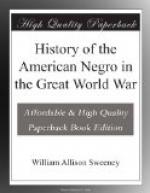“‘It has been wonderful!’ he said, and he gazed with unconcealed tenderness at his men. ’It’s been far beyond my expectations. But these boys deserve it. There’s only one thing missing. I wish some of Gen. Gouraud’s French boys, whom we fought beside, could be here to see it.’
“The Colonel slapped
his hand affectionately upon the shoulder of
his dark-skinned orderly.
“‘How about that, Hamilton, old boy?’ he inquired.
“’That’s
right, Colonel, sir; Gen. Gonraud’s boys sure
would have
enjoyed this day!’
the orderly responded as he looked proudly at
the Colonel.
“There’s
that sort of paternal feeling of the white officers
toward
their men, and that
filial devotion of the men to their officers,
such as exists in the
French Army.
“Much as the white population of the town demonstrated their welcome to the Regiment, it was, after all, those of their own color to whom the occasion belonged. And they did themselves proud In making it an occasion to recall for years in Harlem, San Juan Hill and Brooklyn, where most of the fighters were recruited.
“At the official reviewing stand at 60th street, the kinsfolk and admirers of the regimental lads began to arrive as beforehandedly as 9 o’clock. They had tickets, and their seats were reserved for them. The official committee had seen to that—and nine-tenths of the yellow wooden benches were properly held for those good Americans of New York whom birth by chance had made dark-skinned instead of fair. But this was their Day of Days, and they had determined (using their own accentuation) to be there and to be there early.
“The first-comers plodded across 59th Street from the San Juan Hill district, and it was fine to see them. There seemed to be a little military swank even to the youngsters, as platoons of them stepped along with faces that had been scrubbed until they shone. Had a woman a bit of fur, she wore it. Had a man a top hat—origin or vintage-date immaterial—he displayed that. All heads were up, high; eyes alight. Beaming smiles everywhere. No not quite everywhere. Occasionally there was to be seen on a left sleeve a black band with a gold star, which told the world that one of the Old 15th would never see the region west of Columbus Circle, because he had closed his eyes in France. And the faces of the wearers of these were unlaughing, but they held themselves just as proudly as the rest.
“Few of the welcomers went flagless. No matter whether a man or woman wore a jewel or a pair of patent leather boots as a sign of “class,” or tramped afoot to the stand or arrived in a limousine, nearly every dark hand held the nation’s emblem.
“Nearly every
one wore white badges bearing the letters: “Welcome,
Fighting 15th,”
or had pennants upon which stood out the regimental
insignia—a
coiled rattlesnake of white on a black field.




